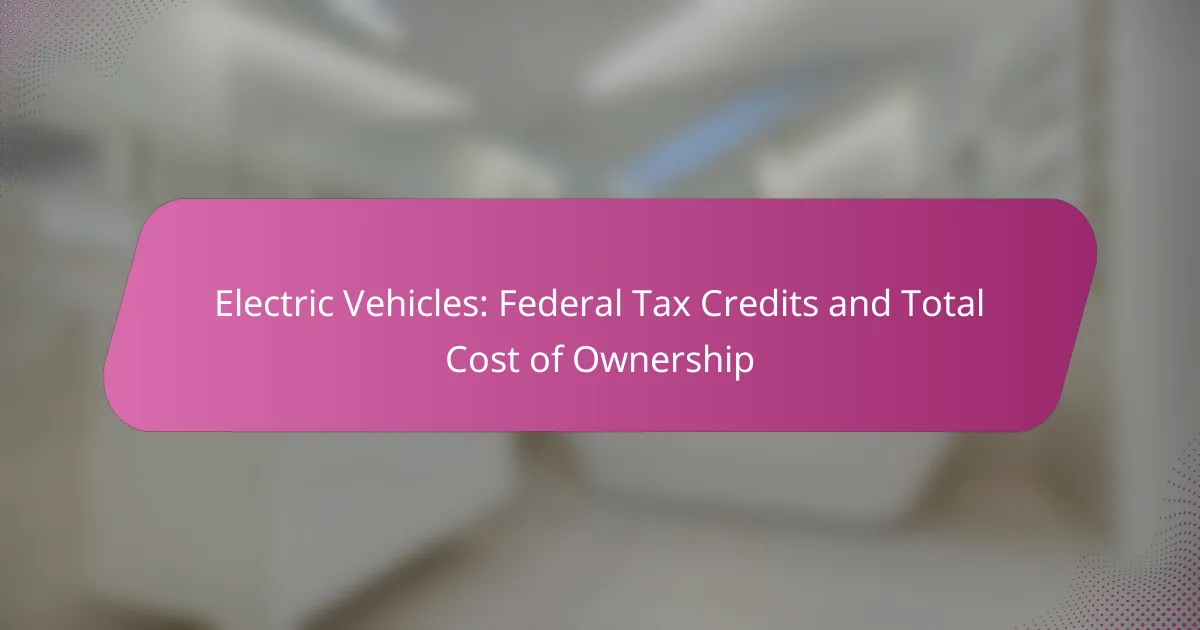Owning an electric vehicle (EV) comes with a unique set of costs that extend beyond the initial purchase price. In your first year, it’s essential to consider expenses such as charging infrastructure, maintenance, insurance, and potential tax incentives. By understanding these factors, you can effectively budget for your EV ownership and avoid unexpected financial burdens.

What are the costs associated with owning an electric vehicle in the US?
The costs of owning an electric vehicle (EV) in the US encompass several key areas, including the purchase price, charging infrastructure, maintenance, insurance, and potential tax incentives. Understanding these expenses can help prospective EV owners budget effectively for their first year of ownership.
Purchase price of electric vehicles
The purchase price of electric vehicles can vary significantly based on the model and features, typically ranging from around $30,000 to over $100,000. While some EVs may have a higher upfront cost compared to traditional gasoline vehicles, many buyers find value in long-term savings on fuel and maintenance.
Consider looking for models that fit your budget while also evaluating available financing options, as some manufacturers offer incentives to make EVs more affordable. Additionally, prices can fluctuate based on market demand and availability.
Charging infrastructure expenses
Charging infrastructure expenses include the cost of home charging stations and public charging fees. Installing a Level 2 home charger can cost between $500 and $2,000, depending on installation complexity and local electrician rates.
Public charging stations may offer free charging, but many require payment, often ranging from $0.10 to $0.40 per kWh. It’s essential to consider your driving habits and the availability of charging stations in your area when budgeting for these expenses.
Maintenance costs compared to gasoline vehicles
Maintenance costs for electric vehicles are generally lower than those for gasoline vehicles due to fewer moving parts and no need for oil changes. Typical annual maintenance for an EV can be around 30% less than that of a conventional car.
However, it’s important to factor in potential costs for battery replacement, which can be significant but often covered under warranty for several years. Regular checks on tires and brakes are still necessary, as they wear out similarly in both types of vehicles.
Insurance premiums for electric vehicles
Insurance premiums for electric vehicles can be higher than those for gasoline vehicles, primarily due to the higher repair costs associated with EVs. On average, you might expect to pay about 10-20% more for insuring an EV.
To mitigate these costs, shop around for insurance providers that offer discounts for electric vehicles or consider bundling policies. Some states also provide incentives that can help lower insurance rates for EV owners.
Tax incentives and rebates available
Tax incentives and rebates can significantly reduce the overall cost of purchasing an electric vehicle. The federal government offers a tax credit of up to $7,500 for qualifying EVs, while many states provide additional rebates or incentives that can range from a few hundred to several thousand dollars.
It’s crucial to check eligibility requirements for these incentives, as they can vary by state and vehicle model. Keeping track of available incentives can help you maximize savings when budgeting for your EV purchase.

What should I budget for the first year of electric vehicle ownership?
Budgeting for the first year of electric vehicle (EV) ownership involves considering various costs, including the initial purchase, charging, maintenance, and insurance. Understanding these expenses will help you plan effectively and avoid unexpected financial burdens.
Initial purchase and financing options
The initial purchase price of an electric vehicle can vary widely, typically ranging from around $30,000 to over $100,000 depending on the model and features. Financing options include traditional loans, leasing, or even government incentives that may reduce the upfront cost.
When considering financing, look for favorable interest rates and terms. Many manufacturers offer special financing deals or incentives that can make the purchase more affordable, so be sure to compare different offers before making a decision.
Estimated charging costs per month
Charging costs for an electric vehicle generally depend on your local electricity rates and how much you drive. On average, monthly charging expenses can range from $30 to $100, depending on usage and the vehicle’s efficiency.
To estimate your monthly charging costs, consider how many miles you drive and your vehicle’s efficiency in miles per kilowatt-hour (kWh). Many EVs consume about 3 to 4 miles per kWh, so you can calculate your costs based on local electricity prices, typically around $0.10 to $0.30 per kWh.
Expected maintenance and repair costs
Electric vehicles generally have lower maintenance costs compared to traditional gasoline vehicles due to fewer moving parts. You can expect to spend around $300 to $600 annually on maintenance, which may include tire rotations, brake fluid changes, and battery checks.
While EVs do not require oil changes, it’s essential to budget for potential repairs, especially as the vehicle ages. Keeping up with regular maintenance can help prevent costly repairs down the line.
Insurance costs breakdown
Insurance costs for electric vehicles can be higher than for conventional cars, often ranging from $1,000 to $2,000 per year. Factors influencing insurance rates include the vehicle’s value, safety features, and your driving history.
To find the best insurance rates, compare quotes from multiple providers and consider any discounts available for electric vehicles. Some insurers offer lower premiums for EVs due to their safety features and lower risk of accidents.

How do electric vehicle ownership costs compare to traditional vehicles?
Electric vehicle ownership costs can be lower than those of traditional vehicles, primarily due to savings in fuel and maintenance. However, factors such as purchase price, incentives, and local electricity rates can significantly influence overall expenses.
Fuel savings over one year
Electric vehicles typically offer substantial fuel savings compared to gasoline-powered cars. On average, electric vehicles can cost around 3 to 5 cents per mile to operate, while traditional vehicles may range from 10 to 15 cents per mile, depending on fuel prices.
For a typical annual mileage of 12,000 miles, this translates to fuel costs of approximately $360 to $600 for electric vehicles versus $1,200 to $1,800 for traditional vehicles. This difference highlights the potential for significant savings over the first year of ownership.
Maintenance savings over one year
Maintenance costs for electric vehicles are generally lower due to fewer moving parts and no need for oil changes. Owners can expect to spend about 30 to 50 percent less on maintenance compared to traditional vehicles.
For instance, while traditional vehicles might incur annual maintenance costs of $500 to $1,000, electric vehicle owners may only pay $300 to $600. This reduction is largely due to the absence of components like exhaust systems and complex transmissions.
Resale value comparison
The resale value of electric vehicles can vary significantly based on market demand and advancements in technology. While some electric vehicles depreciate faster than traditional cars, others maintain their value well, especially as the market for used electric vehicles grows.
On average, electric vehicles may retain about 50 to 60 percent of their original value after three years, compared to 40 to 50 percent for traditional vehicles. Factors such as battery condition, mileage, and model popularity play crucial roles in determining resale value.

What are the key factors influencing electric vehicle budgeting?
Key factors influencing electric vehicle budgeting include the vehicle model and specifications, local electricity rates, and individual driving habits. Understanding these elements helps in estimating the total cost of ownership and planning for expenses effectively.
Vehicle model and specifications
The choice of vehicle model significantly impacts budgeting for electric vehicle ownership. Different models come with varying purchase prices, battery capacities, and range capabilities, which can affect both upfront costs and long-term expenses.
For example, a compact electric car may cost less initially but could have a shorter range compared to a premium model. Additionally, consider features like fast charging capabilities, which can influence charging costs and convenience.
Local electricity rates
Local electricity rates play a crucial role in budgeting for electric vehicle ownership. The cost of charging your vehicle at home or at public stations varies widely based on regional electricity prices.
In the U.S., average residential electricity rates can range from around 10 to 30 cents per kilowatt-hour (kWh). Understanding your local rates helps in calculating the cost per mile driven and estimating monthly charging expenses.
Driving habits and mileage
Your driving habits and mileage directly affect the overall cost of owning an electric vehicle. Frequent long trips may require more charging, while shorter commutes can lead to lower expenses.
For instance, if you drive around 1,000 miles per month, and your vehicle consumes about 4 miles per kWh, you would need approximately 250 kWh of electricity. At a rate of 15 cents per kWh, this translates to about $37.50 in charging costs for the month. Tracking your mileage can help refine your budget and identify potential savings.

What are the financial incentives for electric vehicle owners in the US?
Electric vehicle (EV) owners in the US can benefit from various financial incentives that significantly reduce the overall cost of ownership. These incentives include federal tax credits, state-specific rebates, and utility company programs aimed at promoting EV usage.
Federal tax credits for electric vehicles
The federal government offers tax credits for electric vehicle purchases, which can range from a few thousand to over seven thousand dollars, depending on the vehicle’s battery capacity. To qualify, the EV must meet specific criteria set by the IRS, including being new and not exceeding a certain price threshold.
It’s essential to check the current eligibility requirements and the amount of the credit, as these can change based on legislation and the manufacturer’s sales volume. For instance, some manufacturers may phase out credits once they sell a certain number of EVs.
State-specific rebates and incentives
Many states provide additional rebates and incentives for electric vehicle buyers, which can vary widely. Some states offer cash rebates that can range from a few hundred to several thousand dollars, while others may provide tax exemptions or reduced registration fees.
Researching your state’s specific programs is crucial, as some states have more robust incentives than others. For example, California has one of the most comprehensive incentive programs, while other states may offer limited or no financial support.
Utility company incentives for charging
Utility companies often provide incentives to encourage electric vehicle charging during off-peak hours. These incentives may include lower electricity rates or rebates for installing home charging stations. Some utilities also offer programs that allow EV owners to charge their vehicles at a reduced cost during specific times.
To take advantage of these incentives, contact your local utility provider to learn about available programs and any requirements for participation. This can lead to significant savings on your electricity bill, making EV ownership even more economical.



